Basics
-
01What is a wind farm?A wind farm is a group of wind turbines located in the same area. The individual wind turbines generate electricity, which is then moved using underground cables to a substation on the site of the wind farm. From there, the power is transferred onto the national electricity grid and to people’s homes and businesses.
-
02How do wind turbines work?The wind turns the blades of the turbine and this energy is used by a generator located in a unit behind the turbine’s rotor in what is called a nacelle. The generator converts this energy into electricity.
-
03How much electricity does a wind turbine generate?This depends on the type of turbine and the wind conditions at any one time.
A typical recently installed wind turbine in Ireland might have a generating capacity of 4 MW. So when the wind is blowing it is generating 4 MW of electricity.
To put that in context, if the turbine continues to generate for a little over an hour it will produce as much electricity as an average Irish household will use in a year. -
04What are the main advantages of wind energy?Irish wind energy is clean, affordable, secure and supports the Irish economy.
Clean: Since 2000 Irish wind farms have cut our carbon emissions by a cumulative 47 million tonnes, saving 5 million tonnes in 2024 alone, the equivalent of 1.8 million cars.
The carbon intensity of our electricity system – effectively how dirty it is – has fallen to its lowest level on record.

https://windenergyireland.com/images/files/20250114-finalbaringaweigoodforyourpocket-.pdf
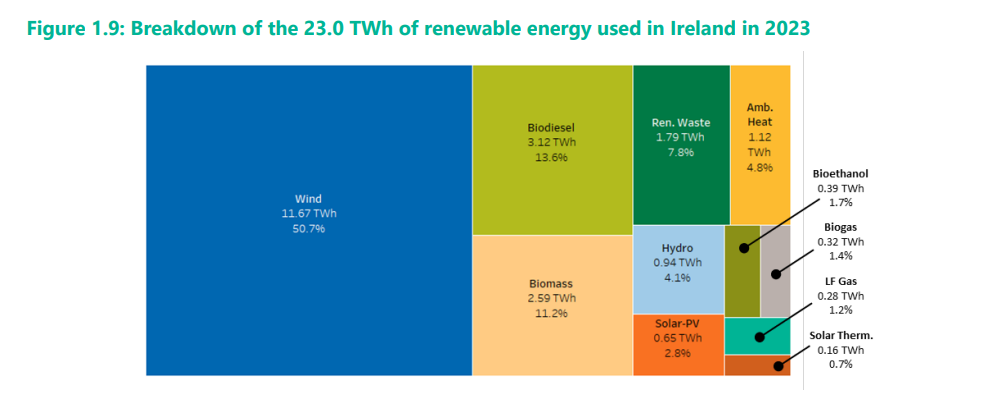
https://www.seai.ie/sites/default/files/publications/energy-in-ireland-2024.pdf
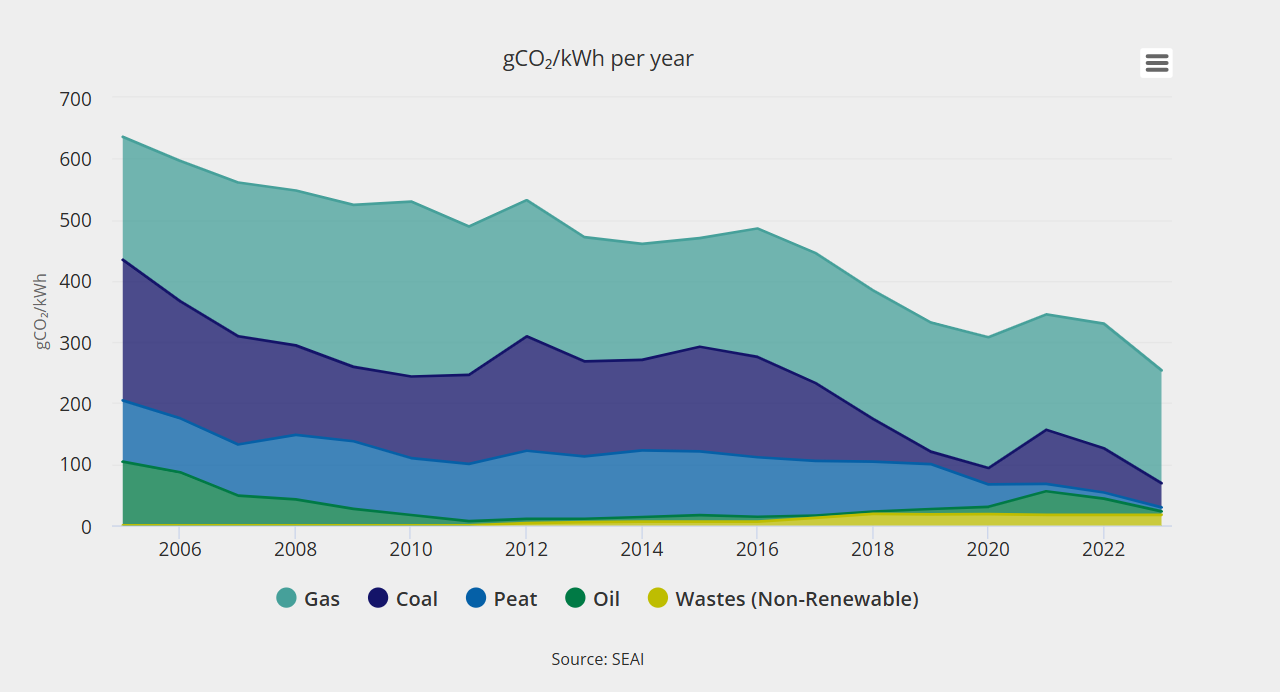
https://www.seai.ie/data-and-insights/seai-statistics/electricity?utm_source=chatgpt.com
Affordable: Since 2000 our wind farms have saved Irish electricity consumers €820 million and, between 2020 and 2023, cut bills by an average of €320 per person.
Secure: The best way to have a secure supply of energy is to produce it here, in Ireland. In 2024 alone Irish wind farms displaced a total of €1.2 billion in imported gas and carbon credits. Using Irish wind farms for our power means money and jobs stay at home.
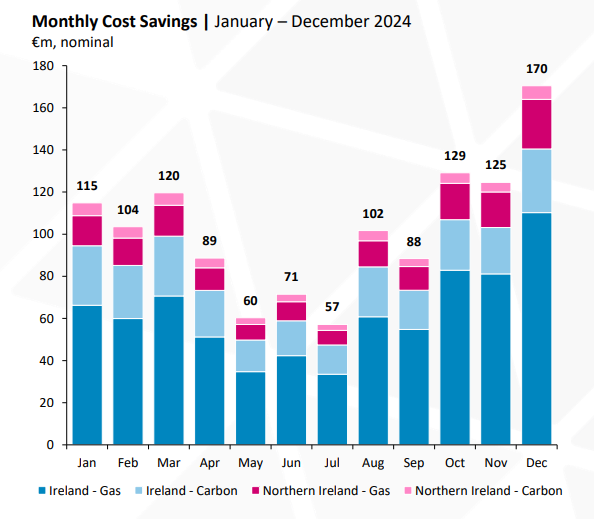
-
05What is the biggest challenge with wind energy?Put simply, the wind doesn’t always blow. If the wind isn’t blowing then the turbines cannot generate electricity. The technical term for this is that wind is ‘intermittent’.
This is why no one – including us – argues that wind farms by themselves can replace oil, gas, coal and peat. It will need a suite of technologies to build a clean, energy-independent, future.
This would include solar energy, battery storage, long-duration energy storage and possibly other technologies like hydro or green hydrogen.
Wind energy in Ireland
-
01How much of Ireland’s electricity is produced by wind?In 2024 Irish wind farms provided 32 per cent of our electricity, 13.3 terawatt-hours (TWh), on an all-island basis. No other country in Europe gets a higher proportion of their electricity from onshore wind than Ireland.
-
02How much wind energy is currently connected to the electricity system?As of October 2025 there are 5,072 MW of wind energy connected to the electricity system in the Republic of Ireland with another 342 MW in construction.
Additionally, there are another 1,366 MW connected in the north of Ireland. -
03How many wind farms are there in Ireland?As of October 2025 there are 334 wind farms in the Republic of Ireland and an additional 69 in the north of Ireland.
-
04Can land underneath a wind turbine still be used for farming activity?Yes, farmers across Ireland continue to successfully rear livestock and grow crops on the land where the wind turbine is located. There would be some disruption to farming activity during the construction of the wind farm but once it is operational then farming can continue as normal.
In fact, some farms are powered by wind turbines like Michael Hoey’s Country Crest farm in north Dublin where they get more than half their power from wind energy! Landowners who agree to have a wind turbine on their land are paid an annual fee by the wind farm owner, providing a regular, long-term source of income. -
05How does a wind farm benefit the local area?You can find out how wind energy is supporting your county by using our County Colours dashboard here. A wind farm typically benefits the local area in two main ways.
First, most wind farms have a Community Benefit Fund, which is a requirement of new wind farms built under the Renewable Electricity Support Scheme. In the most recent report (2024), Irish wind farms paid €6.7 million in funding to local community projects.
Second, wind farms contribute through local rates. In 2025 Irish wind farms paid just under €70 million in commercial rates to rural County Councils. This represents over 10% of the entire commercial rates income for counties Cavan, Donegal, Galway, Mayo, Roscommon, and Tipperary, and more than 20% for Kerry, Leitrim, and Offaly.
This funding repairs local roads, keeps libraries open, and supports small businesses in rural Ireland. -
06Is it true that the electricity system can only carry so much wind?It is true. To ensure the safe and secure operation of the electricity system EirGrid, the transmission system operator, currently limits the amount of power from renewables, wind and solar, onto the system to 75 per cent of demand.
So if, for example, demand on the system was 6,000 MW – which would be fairly high – then wind and solar would only be permitted to supply a maximum of 4,500 MW even if they were able to supply more.
The good news is that this figure has risen from 50 per cent in the mid-2010s and it is due to rise to 80 per cent in the next couple of years. -
07Do wind farms have to turn off because the electricity grid isn’t strong enough?Unfortunately, this is correct. Up until the end of September nearly 17 per cent of the electricity that wind farms on the island of Ireland could have produced was lost. That’s enough to power one in every six Irish homes for a full year.
According to Aurora Energy Research this wasted energy was worth €450 million in 2024 alone. Every time those wind farms are instructed to stop producing electricity expensive gas generation comes onto the system and pushes up everyone’s bills.
This happens when wind farms in, for example, the north-west are producing more electricity than the grid can carry from where it is being generated to where it is needed. When this happens the wind farms are told to reduce the amount of power they’re producing or even shut down.
You can see in this map from MullanGrid, produced in 2023, the problem varies across the country:
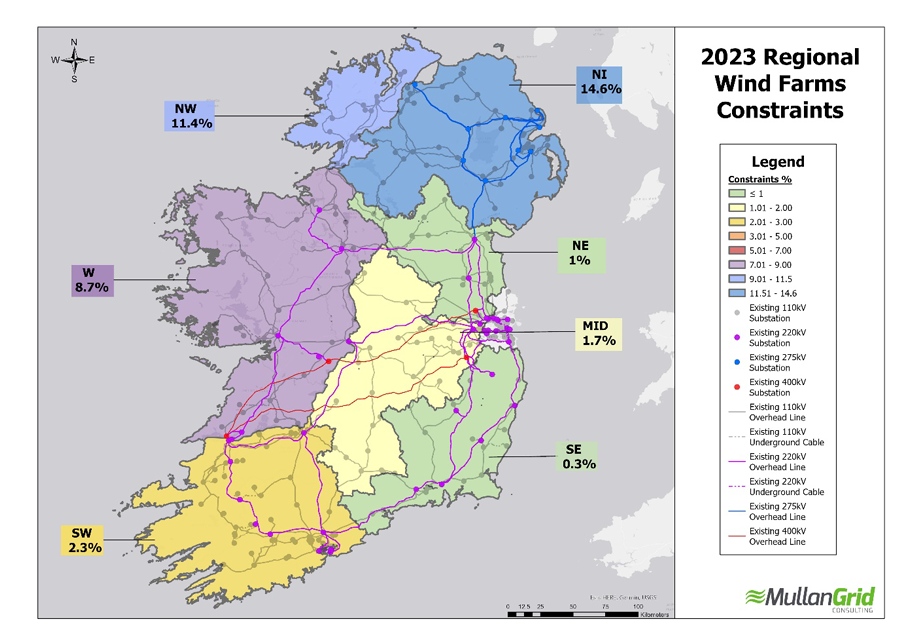
Wind energy and your bills
-
01Is wind energy cheaper than fossil fuels?Onshore wind energy is the cheapest form of new electricity generation in Ireland and, while offshore projects are more expensive than onshore, their prices are competitive or even lower than fossil fuels.
According to the Renewable Power Generations Costs in 2023 report by the International Renewable Energy Agency:
“...the global weighted average LCOE of new onshore wind projects was 67% lower than the weighted average fossil fuel-fired alternative, having been 23% higher in 2010.”
According to the European Electricity Review 2025 from Ember:
“Despite this mixed picture for deployment costs, wind remains competitive against fossil gas generation… the average short-run marginal cost of EU gas power across 2024 was an estimated €96/MWh, reaching a high of around €125/MWh in December. This remains above the typical cost of both onshore and offshore wind in the EU in 2024.” -
02Does wind energy make electricity more affordable?Between 2000 and 2023 Irish wind farms saved consumers €820 million. Between 2020 and 2023, wind and solar together cut bills by an average of €320 per person. These figures include all the costs of building wind energy, including support schemes, network costs, and system services.
Wind farms can do this because they lower wholesale electricity prices — what your provider pays for the power they sell to you. When wind farms generate power, they replace more expensive fossil fuels, bringing down overall prices.
In September 2025, the average wholesale electricity price in Ireland was €94.48, but this fell to €62.01 on windy days and rose to €117.37 when we relied on imported fossil fuels.

The experts agree:- “In the Irish context, wind is putting downward pressure on electricity prices … they would be much higher than they were if not for the wind.” – Dr Muireann Lynch, ESRI.
- “The increased production of electricity from renewables also puts downward pressure on the wholesale price of electricity … Wind … squeezes out more expensive electricity generated from gas or coal.” – Professor John Fitzgerald, Trinity College Dublin.
- “With reference to the costs of electricity, the CRU notes that wind typically has a dampening effect on the wholesale price of electricity given that its marginal cost is close to zero.” – Commission for the Regulation of Utilities.
Wind energy and the environment
-
01How do wind turbines affect the environment?Wind turbines have a low environmental impact compared to fossil fuel generation. They produce no air or water pollution during operation and require no fuel transport. Careful planning ensures minimal effects on wildlife and habitats.
-
02What are the CO₂ savings from wind farms?Between 2000 and 2023 Irish wind farms displaced more than 47 million tonnes of CO₂ — equivalent to the lifetime emissions of more than 1.1 million mid-sized cars.
Wind energy has saved more in carbon emissions than all other renewable technologies combined.
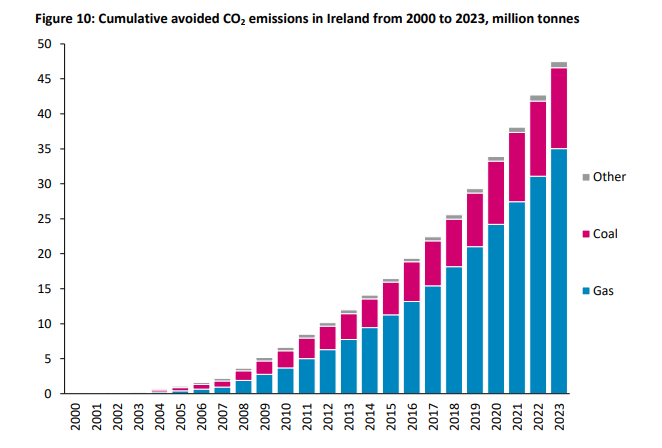
https://windenergyireland.com/images/files/20250114-finalbaringaweigoodforyourpocket-.pdf -
03What are Ireland’s wind energy targets?Ireland’s ambition if for 80 per cent of the country’s electricity to come from renewable sources by 2030.
To achieve this, our targets are to connect 9,000 MW of onshore wind by the end of the decade, up from around 5,100 MW in October 2025, and to build 5,000 MW of offshore wind in the same timeframe. -
04How can I find out more about working in wind energy?A great place to start is with WorkInWind, a campaign aimed primarily at young people and students. You should also check out Green Tech Skillnet, which provides training for people both in and out of employment.
-
05How can I support wind energy?
- First off, follow us on our social channels (links located at the bottom of this page) and help us tell Ireland’s clean energy story.
- Second, let your local councillors, TDs and MEPs know you support Irish energy independence and want the clean, affordable and secure power that Irish wind farms provide.
- Third, support some of the campaigns we support, like BuildOurGrid to demand a stronger electricity grid, or our own Power of Tomorrow campaign to support Irish offshore wind.
Jobs in Wind Energy
-
01How can I find out about vacancies in the wind sector?
See our careers page and our LinkedIn page for the latest job openings in the renewable energy sector.
You may also reach out to our member companies directly. You’ll find their details in our Members Directory. -
02How do I find about more about upskilling to join the wind energy industry?
Whether you are starting your career or thinking about joining the renewable sector from another industry, there are many opportunities to access accredited training courses – many of which are subsidised. Wind Energy Ireland is a partner of Skillnet Ireland and together we facilitate high-quality training through Green Tech Skillnet. See the latest training opportunities here.
-
03Are there many jobs in the wind energy industry?
Research from KPMG has confirmed more than 5,000 people are working in the Irish onshore wind energy industry and this number is expected to rise to more than 7,000 by the end of the year. Thousands more jobs will be created this decade as we build our first new offshore wind farms.
-
04Does the wind industry support the Irish economy?
In 2019 and 2020 together wind energy cut our fossil fuel import bill by a combined €680 million. That is money that stays in Ireland, supporting Irish jobs and communities.
Getting Involved
-
01Can I organise a visit to a wind farm for a group of students or other young people?
There is a wind farm in County Offaly, called Mt Lucas which is operated by Bord na Móna. They have an interactive learning hub and regularly organise tours for interested parties. See their website for more information.
To find another wind farm, see our interactive map where you can view information about the wind farms operating across Ireland.
For other education-related queries, feel free to contact our education lead, This email address is being protected from spambots. You need JavaScript enabled to view it. or check out more resources on our education page. -
02As an individual, what can I do to promote wind energy in Ireland?
If your home is currently supplied by non-renewable energy, investigate switching to a renewable energy provider. This will support current wind energy suppliers and encourages both the expansion of current wind enterprises and entry of new ones.
One of the most helpful things you can do is to advocate for wind energy in your community. Help win the debate on wind energy by writing to newspapers, participate in radio phone-in programmes and talk to your friends and family about the benefits of wind and other sources of renewable energy. Your contribution is extremely valuable and will help promote positive attitudes and perceptions about wind energy.
You can also advocate for stronger policy-backing of wind energy. The best way to change things in Ireland is to show Government, elected representatives and State agencies that an issue is important to a large number of people, and to put pressure on them until they act. While an increasing number of people are concerned about climate change and energy security, many do not make the connection between cutting our carbon emissions and the need to build wind farms or new grid infrastructure like underground cables. We cannot do one without the other. Many of our policymakers are still not hearing the message often enough that they must make climate change and renewable energy infrastructure a top priority. -
03As a business, what can I do to promote wind energy in Ireland?
There are many ways to positively support both wind energy as a renewable resource, and the Irish wind industry. One of the simplest ways is to become a member of the WEI and lend your support to the organisation. Your contribution will help the WEI push and promote the wind agenda in Ireland.
If your business is currently supplied by non-renewable energy, investigate switching to a renewable energy provider. This will support current wind energy suppliers and encourages both the expansion of current wind enterprises and entry of new ones.






